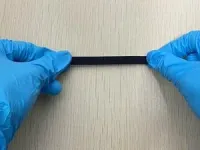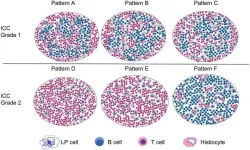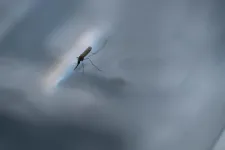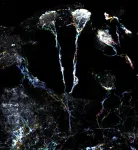(Press-News.org) The UK’s first large scale offshore mussel farm is allowing shellfish reefs to return to parts of the seabed off England’s south coast for the first time in up to 150 years, a new study has revealed.
Researchers have spent the past decade examining the environmental impact of the farm, which was first established in Lyme Bay off the coast of South Devon in 2013.
In that time, the seabed beneath the farm’s ropes has begun to undergo a transformation as mussels from the lines are deposited on the seabed below.
This has seen it change from muddy sediment with limited biodiversity into reefs, which research has shown have the potential to benefit a number of commercial fish and crustacean species and the ecosystem more generally.
However, a historic map – recently uncovered by a Devon-based artist – has revealed this might in fact be a form of restoration rather than creating habitats never seen in the area before.
Dating from 1871, the French map describes a large area of the seabed – stretching from Torquay in the west and beyond Lyme Regis to the east – as being home to “rich shell beds”.
Scientists believe these are likely to have been oyster or mussel reefs that have long since been destroyed through the use of bottom towed fishing gear during the 20th century.
With such practices banned following the designation of the Lyme Bay Marine Protected Area (MPA) – and the mussel farm’s three sites located above the old shell beds – it is allowing the region to become home to shellfish reefs once more.
The map was part of the Marine Biological Association's collection but now donated to artist Hannah Wisdom. She shared it with scientists at the University of Plymouth, who have been working with fishing communities along the Lyme Bay coastline to monitor the impacts of the MPA since 2008, and the mussel farm since 2013.
Dr Emma Sheehan, Associate Professor in Marine Conservation and senior author on the study, said: “When we first started to monitor the mussel farm in 2013, we hoped to find evidence of its potential to restore the health of the seabed. That is something we have shown consistently, with new species of marine flora and fauna regularly being seen within its ropes and on the seabed. However, to find out that such habitats were found in the region 150 years ago is really exciting. It shows that the farm is not only having a positive impact on the health of the ocean now, but also returning the seabed to some semblance of its former state.”
In the study, published in Science of the Total Environment, researchers also highlight how the shellfish reefs that have been recreated over the past decade are being used by a number of commercially important species.
Using a combination of acoustic tags and underwater monitoring equipment, scientists found that individual European lobsters (Homarus gammarus) remained beneath the farm for up to 283 days using both the farm anchors – and areas of seabed dominated by fallen mussels – for feeding and refuge.
By contrast, brown crabs (Cancer pagurus) showed little willingness to stay within the farm’s infrastructure and all tagged crabs had left the area of the farm under surveillance within nine days.
This, scientists say, could be evidence that the mussel farm is providing refuge and similar feeding opportunities for lobster and crab as their typical habitat on rocky reefs.
John Holmyard, Managing Director at Offshore Shellfish Ltd which manages the Lyme Bay mussel farm, said: “These findings show that an area of flat, muddy and degraded seabed can be restored into a productive, biodiverse habitat. Through the location of a carefully designed offshore mussel farm, we are creating an effect comparable to that seen from the statutory protection of a rocky reef area. It is enabling lobsters and crabs to feed and grow within the protection of the farmed area before they move out and provide further benefits to surrounding fisheries.”
END
Historic map reveals how mussel farm is bringing shellfish reefs back to the seabed
2024-08-14
ELSE PRESS RELEASES FROM THIS DATE:
Power up your health with self-sustaining electronics
2024-08-14
Imagine a coat that captures solar energy to keep you cozy on a chilly winter walk, or a shirt that can monitor your heart rate and temperature. Picture clothing athletes can wear to track their performance without the need for bulky battery packs.
University of Waterloo researchers have developed a smart fabric with these remarkable capabilities. The fabric has the potential for energy harvesting, health monitoring, and movement tracking applications.
The new fabric developed ...
Histopathologic features and differential diagnosis in challenging cases of nodular lymphocyte predominant B-cell lymphoma/Nodular Lymphocyte Predominant Hodgkin Lymphoma
2024-08-14
This review offers an in-depth exploration of Nodular Lymphocyte Predominant Hodgkin Lymphoma (NLPHL), highlighting its distinct characteristics across various domains such as epidemiology, clinical presentation, histopathology, immunophenotype, genetic findings, and challenges in differential diagnosis.
Epidemiology and Clinical Presentation
NLPHL is a relatively rare subtype of Hodgkin lymphoma, comprising approximately 10% of all Hodgkin lymphoma cases. It predominantly affects males, with a higher incidence observed ...
Trojan horse method gives malaria parasites a taste of their own medicine
2024-08-14
More than a quarter of Australians over the age of 50 take cholesterol-lowering drugs to prevent heart disease and strokes, but our bodies also need cholesterol to survive. Now, scientists from The Australian National University (ANU) say its role as a basic building block of life holds the key to treating deadly diseases caused by parasites, including malaria.
The researchers have developed a trojan horse method that tricks malaria parasites into ingesting a fatal dose of drugs by exploiting the parasite’s need for cholesterol to survive. By attaching ...
Singapore scientists discover breakthrough method to activate dormant stem cells in the brain
2024-08-14
Scientists from Duke-NUS Medical School and the Mechanobiology Institute (MBI) at the National University of Singapore (NUS) have discovered a novel pathway to wake up dormant neural stem cells, offering potential new therapies for neurodevelopmental disorders such as autism, learning disabilities, and cerebral palsy.
In the mammalian adult brain, most neural stem cells, which originate from the nervous system and can grow into various types of brain cells, stay dormant until they receive specific signals that activate them. Once woken up, they produce new neurons, aiding in brain repair and growth.
Defects in neural stem cell activation ...
Rare archaeological site reveals ‘surprising’ Neanderthal behaviour at Pyrenees foothills
2024-08-14
An unchartered area in the foothills of the Southern Pyrenees in Spain is providing insights into a poorly known period of Neanderthal history, offering clues that could help archaeologists uncover the mystery of their downfall, according to new research from The Australian National University (ANU).
Abric Pizarro is one of only a few sites worldwide dating from 100,000 to 65,000 years ago during a period called MIS 4. The researchers have gathered hundreds of thousands of artefacts, including stone tools, animal bones and other evidence, providing significant data about the Neanderthal way of life during that time -- largely unknown in human history until now.
The findings ...
How our biases are reflected in how fast we make decisions
2024-08-14
Quick decisions are more likely influenced by initial biases, resulting in faulty conclusions, while decisions that take time are more likely the result in better information, according to new research led by applied mathematicians at the University of Utah.
A team that included Sean Lawley, an associate professor of mathematics, and three former or current Utah graduate students used the power of numbers to test a decision-making model long used in psychology.
They developed a framework to study the decision-making processes in groups of people holding various levels of bias.
“In large populations, what we see is that slow deciders are making more accurate ...
Brigham study finds shingles increased risk of subsequent cognitive decline
2024-08-14
A new study led by investigators from Brigham and Women’s Hospital, a founding member of the Mass General Brigham healthcare system, found that an episode of shingles is associated with about a 20 percent higher long-term risk of subjective cognitive decline. The study’s findings provide additional support for getting the shingles vaccine to decrease risk of developing shingles, according to the researchers. Their results are published in Alzheimer's Research & Therapy.
"Our findings show long-term implications of shingles and highlight the importance of public health efforts to prevent and promote uptake of the shingles vaccine," said ...
Australians outlive their peers in high income Anglophone countries by 1-4 years
2024-08-14
Australians outlive their peers in 5 high income English speaking countries, including the UK and the US, by between 1 to 4 years, finds an analysis of international longevity data, published in the open access journal BMJ Open.
Most of this advantage accrues between the ages of 45 and 84, with death rates from drug and alcohol misuse, screenable/treatable cancers, and cardiovascular and respiratory diseases all lower, the analysis shows.
While high income countries achieved good life expectancy gains during the 20th century, the trends have been much less favourable in the 21st century, even before the COVID-19 pandemic, note ...
Lack of purpose and personal growth may precede mild cognitive impairment
2024-08-14
Feeling that your life lacks purpose and that there are few opportunities for personal growth in older age may precede the development of mild cognitive impairment (MCI), a frequent precursor of dementia, suggests research published online in the Journal of Neurology Neurosurgery & Psychiatry.
These aspects of psychological wellbeing noticeably decline 2 to 6 years before MCI is diagnosed, even in the absence of evident signs, and irrespective of whether those affected go on to develop dementia, the findings ...
Australia offers lessons for increasing American life expectancy
2024-08-14
UNIVERSITY PARK, Pa. — Despite being home to some of the world’s most dangerous animals, Australia has led the English-speaking world in life expectancy for the last three decades. As for other high-income Anglophone countries, the Irish saw the largest gains in life expectancy, while Americans have finished dead last since the early 1990s, according to a team of social scientists led by a Penn State researcher.
The team published their findings today (August 13) in the journal BMJ Open.
“One lesson ...







